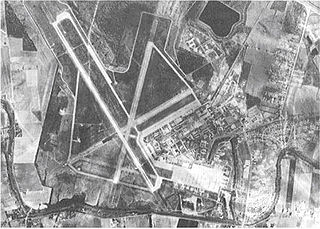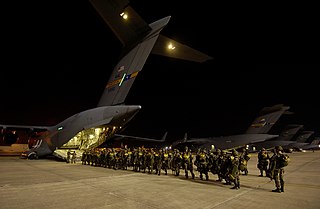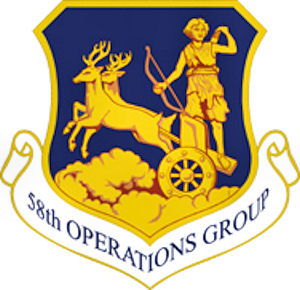
England Air Force Base is a former United States Air Force base in Louisiana, located 5 miles (8.0 km) northwest of Alexandria and about 170 miles (270 km) northwest of New Orleans. Originally known as Alexandria Army Air Base, on 23 June 1955 the facility was renamed England Air Force Base in honor of Lt Col John Brooke England (1923–1954).

The 353rd Special Operations Wing is an operational unit of the United States Air Force Special Operations Command, stationed at Kadena Air Base, Japan.

The 319th Special Operations Squadron was first activated in September 1944 as the 319th Troop Carrier Squadron (Commando) and served in the China-Burma-India Theater during World War II. It provided airlift support and conducted airborne drops and glider operations for Allied troops in Burma, central China, and French Indochina in the last year of World War II.

The 415th Special Operations Squadron is a United States Air Force unit. It is assigned to the 58th Operations Group at Kirtland Air Force Base, New Mexico.

The 24th Special Operations Wing is a United States Air Force active-duty wing that was activated on 12 June 2012. Its headquarters is at Hurlburt Field, Florida and it has component groups located in North Carolina, Georgia and Washington. It is the third special operations wing in Air Force Special Operations Command (AFSOC).

The 310th Special Operations Squadron is an active United States Air Force unit, based at Cannon Air Force Base, New Mexico. It was most recently activated in 2021 as part of the 27th Special Operations Group, flying the U-28A for Air Force Special Operations Command.

The 317th Airlift Squadron is part of the 315th Airlift Wing at Charleston Air Force Base, South Carolina. It operates C-17 Globemaster III aircraft supporting the United States Air Force global reach mission worldwide. It continues the histories of three squadrons with airlift missions that bear the number 317.

The 78th Attack Squadron is an Air Force Reserve Command (AFRC) unit under the 926th Wing, Nellis Air Force Base, Nevada and Tenth Air Force at Naval Air Station Joint Reserve Base Fort Worth, Texas. The 78 ATKS conducts operations from Creech Air Force Base, Nevada in conjunction with their active-duty associates in the 432d Wing.

The 6th Attack Squadron is an active United States Air Force unit, assigned to the 49th Wing at Holloman Air Force Base, New Mexico. The squadron is a formal training unit for crews learning to operate unmanned aerial vehicles.

The 548th Combat Training Squadron is a United States Air Force squadron assigned to the 57th Operations Group at Fort Polk, Louisiana. It is geographically separated from the 57th, whose headquarters are at Nellis Air Force Base, Nevada. At Fort Polk, the squadron controls multi-service close air support and forward air control aircraft and tactical air control assets in combat exercises with the US Army Joint Readiness Training Center.

The 549th Combat Training Squadron is a non-flying United States Air Force unit. It is assigned to the 57th Operations Group, and is stationed at Nellis Air Force Base, Nevada. It conducts air support and air interdiction sorties in "Green Flag (West)" exercises to train USAF fighter pilots and the aerospace power component to the US Army's brigade combat training.

The 562nd Flying Training Squadron is an inactive United States Air Force unit. It was part of the 12th Flying Training Wing at Randolph Air Force Base, Texas, where it operated the Boeing T-43 Bobcat conducting navigator training from 1993 until inactivating on 19 November 2010.

The 563rd Flying Training Squadron is an inactive United States Air Force unit. It was part of the 12th Flying Training Wing at Randolph Air Force Base, Texas, where it operated the Boeing T-43 Bobcat conducting navigator training until inactivating on 19 November 2010.

The 65th Special Operations Squadron is an Air Force Special Operations Command unit which flies the General Atomics MQ-9 Reaper at Hurlburt Field, Florida. The squadron was first activated as the 65th Bombardment Squadron in January 1941, one of the original squadrons of the 43rd Bombardment Group. Following the attack on Pearl Harbor, the squadron participated in antisubmarine patrols until January 1942, when it moved to Australia and the Southwest Pacific Theater. It moved forward with US forces through New Guinea and the Philippines, moving to Ie Shima shortly before V-J Day for operations against Japan. It earned two Distinguished Unit Citations and a Philippine Presidential Unit Citation for combat operations. During this period, a crew from the 65th became the most decorated aircrew in United States history, when their B-17 fought off twenty Japanese fighters during a photo reconnaissance mission. The squadron was inactivated in the Philippines in April 1946.

The 58th Operations Group is the operational flying component of the United States Air Force 58th Special Operations Wing. It is stationed at Kirtland Air Force Base, New Mexico.

The 14th Weapons Squadron is a United States Air Force unit. It is assigned to the USAF Weapons School, stationed at Hurlburt Field, Florida.

The 775th Troop Carrier Squadron is an inactive United States Air Force unit. It was last assigned to the 1st Air Commando Wing at Hurlburt Field, Florida in July 1964.

The 26th Intelligence Squadron is an intelligence organization of the United States Air Force, located at Buckley Space Force Base, Colorado.

The 522nd Special Operations Squadron, nicknamed the Fireballs, was a unit of the United States Air Force. It was part of the 27th Special Operations Group, the flying component of the 27th Special Operations Wing at Cannon Air Force Base. It was the first to operate the MC-130J Commando II.

The 604th Special Operations Squadron is an inactive United States Air Force squadron It was last active at Bien Hoa Air Base, Vietnam, where it was inactivated in September 1970.




























